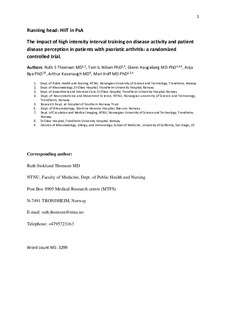The impact of high intensity interval training on disease activity and patient disease perception in patients with psoriatic arthritis: a randomized controlled trial
Thomsen, Ruth Stoklund; Nilsen, Tom Ivar Lund; Haugeberg, Glenn; Bye, Anja; Kavanaugh, Arthur; Hoff, Mari
Journal article, Peer reviewed
Accepted version
Permanent lenke
http://hdl.handle.net/11250/2586914Utgivelsesdato
2018Metadata
Vis full innførselSamlinger
Sammendrag
Objective
The aim of this study was to evaluate the impact of high intensity interval training (HIIT) on disease activity and patient disease perception in patients with psoriatic arthritis (PsA), and evaluating if a potential effect could be sustained for a longer period.
Methods
We randomly assigned 67 PsA patients (43 women and 24 men) to an intervention group performing HIIT for 11 weeks or a control group who were instructed to not change their physical exercise habits. Outcomes were assessed at three and nine months with the patient global assessment (PGA), fatigue, and pain measured on a 100 mm visual analog scale and the composite disease activity score of 44 joints (DAS44) was calculated. We used linear mixed models to calculate mean difference with 95% confidence interval (CI) between the groups according to the intention‐to‐treat principle.
Results
At three months there was no clear difference in PGA (‐0.49; 95% CI ‐10.91 to 9.94), DAS44 (‐0.08; 95% CI ‐0.36 to 0.20) or pain intensity (5.45; 95% CI ‐4.36 to 15.26) between the groups. However, the HIIT group reported less fatigue (‐12.83; 95% CI ‐25.88 to 0.23) than the control group. There was no evidence of long‐term effects of HIIT on outcomes measured at nine months.
Conclusion
HIIT showed no clear effects on disease activity markers in patients with PsA, but the exercise group reported meaningfully less fatigue after the intervention period. This study suggests that PsA patients tolerate HIIT without deterioration of disease activity and with improvement in fatigue.
